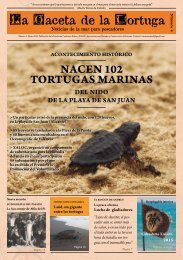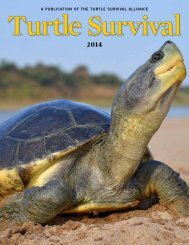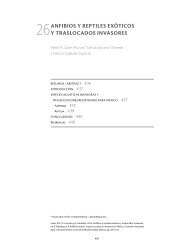tsrp63entire
tsrp63entire
tsrp63entire
You also want an ePaper? Increase the reach of your titles
YUMPU automatically turns print PDFs into web optimized ePapers that Google loves.
Action<br />
number<br />
Action<br />
Priority<br />
2013<br />
2014<br />
2015<br />
2016<br />
2017<br />
2018<br />
Topic 1—Distribution<br />
1.1 Prepare distribution survey best practice guidelines E<br />
1.2 Identify priority sites for survey and undertake surveys H<br />
Topic 2—Monitoring<br />
2.1 Develop best practice monitoring guidelines E<br />
2.2 Develop protocol for monitoring priority populations E<br />
2.3 Conduct robust long-term monitoring in priority populations E<br />
2.4 Establish monitoring in populations created through translocation H<br />
2.5 Report on status of monitored populations to Recovery Group H<br />
Topic 3—Management of threats<br />
3.1 Select two sites for each frog species where predator control will occur E<br />
3.2 Initiate or continue control of predators of native frogs at selected sites H<br />
3.3 Maintain island biosecurity E<br />
3.4 Ensure frog hygiene protocols are followed E<br />
3.5 Conduct regular monitoring of chytrid fungus at selected sites M<br />
Topic 4—Translocation<br />
4.1 Review success of prior translocations and make recommendations E<br />
4.2 Supplement or rescue translocated populations as required by 4.1 E<br />
4.3 Monitor translocations over an appropriate timeframe E<br />
4.4 Select suitable sites for establishing new frog populations E<br />
4.5 Identify and implement a new site for an Archey’s frog translocation E<br />
4.6 Identify and implement a new site for a Maud Island frog translocation H<br />
Topic 5—Captive management<br />
5.1 Refine husbandry techniques for Archey’s and Hochstetter’s frogs E<br />
5.2 Prepare operative native frog captive management plans E<br />
5.3 Define conditions where appropriate to end captive management for each species E<br />
5.4 Review captive management plans every 2 years and circulate changes E<br />
5.5 Establish a captive population of Maud Island frog and refine husbandry techniques H<br />
5.6 Amend the captive husbandry manual to include new species E<br />
5.7 Identify any priority populations/ESUs for captive management H<br />
Topic 6—Habitat restoration<br />
6.1 Identify sites where habitat restoration is essential to species/ESU survival E<br />
6.2 Initiate restoration at sites essential for species/ESU survival H<br />
6.3 Identify sites where restoration is necessary for population expansion M<br />
Topic 7—Capability<br />
7.1 Provide training and support for key staff and stakeholders H<br />
7.2 Develop resources for monitoring and management techniques H<br />
Topic 8—Planning / legal protection<br />
8.1 Mitigate potential adverse land use impacts using statutory protection E<br />
8.2 Survey priority sites on private land for native frog presence H<br />
8.3 Determine impacts of land use activities using research H<br />
8.4 Ensure local/regional authorities are aware of statutory obligations M<br />
Topic 9—Recovery planning<br />
9.1 Review this recovery plan and draft a new version if required E<br />
9.2 Review Recovery Group membership biennially E<br />
Continued on next page<br />
38 Bishop et al.—Native frog recovery plan, 2013–2018





